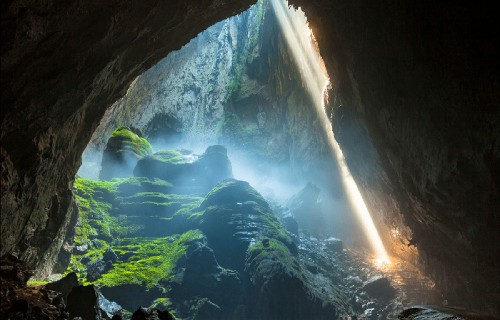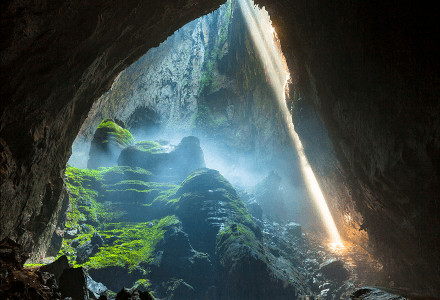
We sincerely hope that you greatly enjoy this article about 3 Captivating Caves of Aisa. Obviously the sites listed here constitute only a tiny percentage of such wonders found in this region. Despite that, we feel that they serve as excellent examples of their type.
These specific geological wonders will astound you with their various qualities. Each understandably shares some characteristics with the others, to be certain. Nevertheless, each of them also contains features and traits that distinguish them form the others.
Borra Caves
Borra Caves Facts
- Leading off this compilation of 3 Captivating Caves of Asia comes the marvel that we think will appeal to you, known as the Borra Caves.
- Most impressively, the truly incredible location quite easily ranks as one of the largest known caves in the country in which it formed. Its amazing wonders don’t end there, however. The truly magnificent site also holds yet another impressive status.
- That’s because the fabulous site ranks as the deepest known cave in that same country. Quite surprisingly, this natural marvel of geology also sits at an usually high altitude. Though unknown, of course, such a combination nonetheless qualifies as unusual.
- The local indigenous population, furthermore, long knew of the presence of the natural marvel. In fact, they knew of its existence for countless centuries prior to its discovery by Europeans. Extensive archaeological evidence pointing to this fact exists.
- The caves first became known to outsiders, however, in 1807. This fortuitous discovery occurred as an accidental result of a geological survey of the country. William King George came across the site in the process of conducting that survey.
- Finally, this truly fabulous natural site also has yet one more reason to stand out. This one, though, comes in the form of a sociological importance. That’s because the Borra Caves also plays an important role in the religious beliefs of the local population.
- As part of these local beliefs, the native residents hold several legends revolving around the astounding caves. In fact, this even extends to the construction and maintenance of a small temple outside its opening, built at a currently undetermined date.
Borra Caves Physical Description
Perhaps most notably of all, the endlessly amazing Borra Caves extend for a relatively great distance. That’s due to the fact that they have a total length measuring about 660 ft (200 m) in total. In fact, that’s an impressive measurement for a natural formation of this type.
The site also boasts a remarkably large opening. This measures roughly 330 ft (100 m) in width, and about 246 ft (75 m) in total height. Furthermore, this well known and always fascinating site also boasts numerous natural features, especially stalactites and stalagmites.
The wondrous stalactites range in length from 0.3 – 11.5 ft (0.1 – 3.5 m) in length. Meanwhile, the equally marvelous stalagmites have an average length of 3.9 ft (1.2 m). The stunning location also boasts even more magnificent features to dazzle the observer, though.
That’s because the awesome site also contains numerous fascinating limestone columns. These comparatively massive features average roughly 20 ft (6 m) in height and about 2.5 ft (0.75 m) in overall width. But the marvels of the Borra Caves do not simply stop there.
Nature, it seems, worked to create multiple wonders in this location. In point of fact, the surrounding area consists largely of impressive mica formations. Due to the unique nature of this site, numerous precious stones also appear within the mica, including rubies.
Borra Caves Location, Formation, and Ecology
Remarkably, the magnificent Borra Caves formed in a part of the world that’s itself quite remarkable. This marvel of Nature formed on what now represents the East Coast of the country of India, in Asia. Herein, it blends in perfectly with many other natural wonders.
Rather more specifically, this geological wonder formed in what is now the Ananthagiri hills, in the district of Andhra Pradesh. The Gosthani River, more precisely, created the incredible site. That’s true because it actually originates within the caves, before flowing onward.
In fact, the flowing water, over countless thousands of years, carved the caves as they exit now. It did this through its inexorable actions against the relatively soft limestone of the region. That’s not an uncommon pattern of formation, but here it’s taken to another level.
While it may seem like an inhospitable location, a multitude of life actually teems within the boundaries of the Borra Caves. For one thing, several species of fauna inhabit the caves. These mainly, but not solely, include various types of bats, and the golden gecko.
But, this seemingly miraculous location also serves as home to several varieties of very tiny crustaceans, however. Very strong evidence further indicates that this fantastic site was known to ancient man, in the quite distant past, as well as modern humans.
This holds true due to the facts uncovered by numerous expeditions to the site. As a result of these, researchers discovered numerous archaeological artifacts within the confines of the caves. To their amazement, some of these date back roughly 50,000 years.
Reed Flute Cave
Reed Flute Cave Facts
- Appearing second in this listing of 3 Captivating Caves of Asia, though only due to random selection, is the mind-blowing marvel known as Reed Flute Cave.
- The Reed Flute Cave represents a natural limestone cave in Guilin, Guangxi, China, in Asia. It draws its name from the presence of a species of reed growing outside the cave.
- This reed also remains rather common in the making of flutes, even today.
- The interior of this geological masterpiece sits full of a wide variety of stone pillars, stalactites, and rock formations which were created by carbonate deposition over millions of years.
- Also, among the many remarkable formations found within the cave, one even bears a strong resemblance to the Statue of Liberty, in the United States.
Reed Flute Cave Physical Description
The incredible Reed Flute Cave measures roughly 790 ft (240 m) in length. Heights of the roof also vary greatly from location to location over its length.
This walls of this rather astonishing natural beauty consist principally of limestone, which has been extensively eroded by water.
The cave also serves as home to numerous collections of impressive stalagmites and stalactites. These formed over thousands of years via the action of carbonate deposition.
Further, it also contains several large bodies of water.
Reed Flute Cave Human History
The Reed Flute Cave was popular to local inhabitants in ancient times. Mysteriously, people forgot about the cave for nearly 1,200 years or until the mid 20th century.
Refugees fleeing from Japanese troops in the 1940s accidentally rediscovered the cave and made it popular once again.
The cave also hides more than 70 inscriptions written in ink and dating to as early as 792 AD, in the time of the Tang Dynasty.
The inscriptions indicate that the rather long cave was a popular tourist location even then.
Jeita Grotto
Jeita Grotto Facts
- Closing out this article about 3 Captivating Caves of Asia is the stunning masterpiece of geological processes known simply as the Jeita Grotto.
- This marvel of Nature, largely unknown outside of its immediate area, goes by a comparatively simple name. Perhaps most notably, however, the breathtaking site isn’t just another cave. That’s because it is significantly important to the region it formed in.
- That importance isn’t restricted to just one way, though. In point of fact, it’s impact on the region occurs in cultural, social, and even economic ways. The fabulous site has, in fact, played a relatively major role in the region since long before our modern era.
- Archaeological evidence indicates that ancient man used the lower section in prehistoric times, and over an extensive period. Researchers have yet to find any sign of use during that same period in the upper section, though inverstigations continue.
- For reasons yet to be determined, its ancient inhabitants apparently abandoned it long before modern times. Reverend William Thomson accidentally rediscovered it in 1836, while exploring. It appears to have been completely unknown during the interim.
- Due to its importance to the region, it now serves as the national symbol of the country it lies in. It’s magnificence does not go unnoticed now, though. The Jeita Grotto made the final round of consideration in the New 7 Wonders of Nature competition.
Jeita Grotto Physical Description
The stunning Jeita Grotto holds many surprises for its visitors. This begins with the fact that it’s actually a system of two caves. While these remain separate, the caves interconnect. Together, the amazing system possesses an overall length totaling about 5.6 mi (9 km).
Because of its size, it ranks as the longest cave system in its part of the world. The upper cave measures roughly 6,990 ft (2,130 m) in length. The lower section, meanwhile, measures about 20,300 ft (6,200 m) long. Heights also vary, but reach as high as 39 ft (12 m).
It musn’t be overlooked, though, that this marvelous location houses many individual wonders, as well. These include columns, ponds, curtains, stalactites and stalagmites. In fact, it also holds the largest known stalactite in the world, at 27 ft (8.2 m) long.
It also contains three huge, separate natural chambers, as well as a subterranean river. The largest of the chambers measures an impressive 390 ft (120 m) long. The river it holds further serves as the source of drinking water for 1.5 million local residents.
Jeita Grotto Location, Geology, and Importance
The dazzling site now called the Jeita Grotto formed in an area of the world already renowned for its many remarkable natural features. That’s because the dazzling dual cave system formed in what mankind now knows as the country of Lebanon, in western Asia.
Within that region, the cave system sits about 11 mi (18 km) from the city of Beirut. That location makes its remaining unnotieced so long even more amazing. Its location places it on the western side of the Lebanon Mountains. More precisely, it’s in the Nahr al-Kalb valley.
Adding to its splendor is its proximity to the coast. Incredibly, the system sits only 3.1 mi (5 km) from coast of the Mediterranean Sea. This location places it in the Nahr al-Kalb valley. Its naturally formed opening lies approximately 330 ft (100 m) above sea level.
Not only the area around the Jeita Grotto, but the entire region has a largely limestone geology. This therefore allowed for the formation of the impressive limestone karst caves. The process further occurred over a currently undetermined span of millennia.
It now has rather varied usefulness in the region. Most notably, it remains one of the most important tourist sites in the region. But sadly, its use as a water source may soon come to an end. Pollution levels in the water due to agricultural runoff has begun to increase.
3 Captivating Caves of Asia
We truly hope that you have thoroughly enjoyed reading, and perhaps learning from, this article about 3 Captivating Caves of Asia. We further hope that it has instilled in you a desire to learn of more such marvels. If so, we invite you to peruse our other articles.
These natural wonders, in most cases, have been around for thousands of years. In many cases, the features have existed for many milions of years. Let’s do all that we can to preserve them in their pristine state for our posterity to enjoy, just as we do.
Check out our other articles on 4 Refreshingly Remarkable Rivers, 4 Fabulous Central American Trees, Earth’s Many Magical Moths, The Mighty Tornado, 4 Giants of Their Kind

